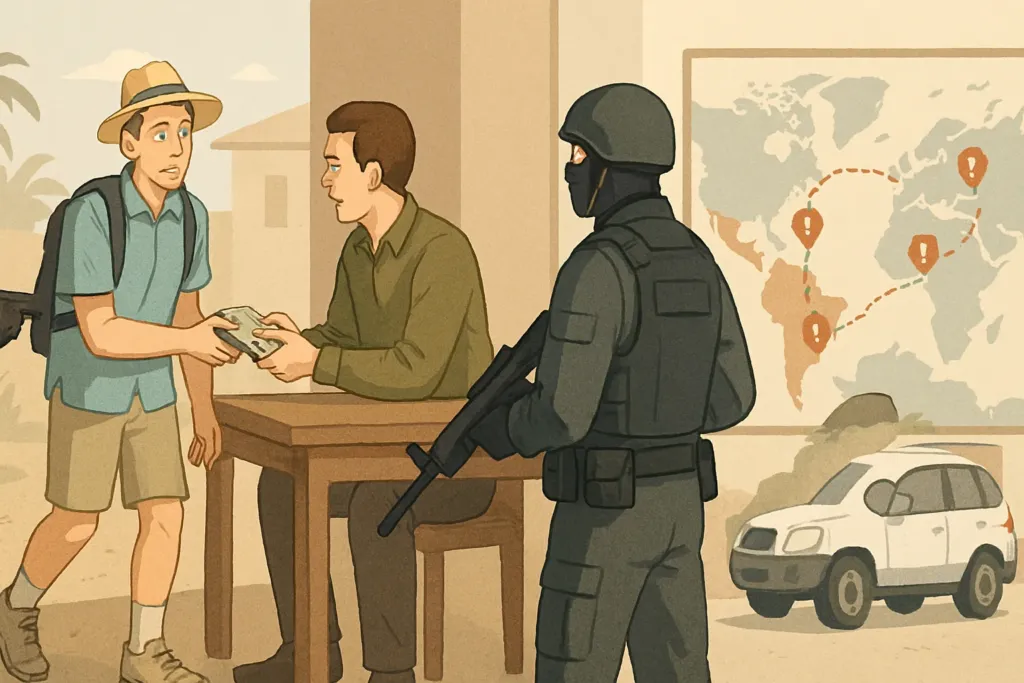What we study and why it’s difficult
There’s no global database of tourist-specific kidnappings. Police reports, insurer disclosures, government advisories—each is partial or secretive. Many incidents go unregistered, ransom details are kept confidential, and victims are often logged as “foreign nationals” or “expats” rather than tourists. Our analysis draws on security bulletins, K&R insurance reports, conflict zone studies, and a small number of publicly confirmed cases.
Kidnap geography: where and how tourists are taken
Between 2019 and 2025, confirmed tourist abductions occurred in several zones:
— Haiti — the capital region, especially Port-au-Prince: since 2021, an explosion of cases, over 3,000 reported kidnappings annually by 2023–24; tourists, aid workers, and business visitors have appeared among victims.
— Sahel: Mali, Burkina Faso, Niger — dozens of foreign kidnappings, notably on highways and in non-secured parks.
— Nigeria — particularly the northwest, northeast, and Niger Delta: motives mix ransom and political leverage; tourists are rarely targeted but some incidents have occurred.
— Philippines: Sulu and Basilan — Abu Sayyaf group historically targeted boaters and divers; recent decline, though risk persists.
— Mexico — express kidnappings in urban areas; longer K&R cases in border states (Guerrero, Tamaulipas); tourists are seldom victims, especially within resorts.
— Ecuador — rising organized crime since 2023; incidents involving ransom and foreign nationals confirmed in cities and some border zones.
— Somalia, eastern DR Congo, CAR, Libya, Afghanistan — high threat levels, but tourism is virtually nonexistent.
Average ransom demands and captivity duration
— Haiti: demands range USD 10,000–200,000; payouts typically USD 3,000–50,000. Captivity averages 2–10 days.
— Sahel: demands USD 500,000–5 million; reported payouts USD 100,000–500,000. Detention averages 2–3 months; some cases exceed 6.
— Nigeria: demands USD 5,000–100,000; payouts typically USD 1,000–20,000. Duration: 3–14 days.
— Philippines: demands USD 100,000–1 million; captivity spans weeks to months.
— Mexico: express cases demand USD 200–2,000 (duration: 2–24 hrs); classic K&R ranges from USD 100,000–1 million, payouts USD 15,000–75,000, with captivity of 5–20 days.
— Ecuador and Venezuela: demands USD 1,000–30,000; 1–7 days in custody.
— Somalia and maritime piracy: past ransom sums reached USD 2–3 million; detention lasted months.
End outcomes: payment, harm, death
— Criminal cases: 60–80% of Latin American kidnaps result in financial settlement. Express cases involve rapid ATM withdrawals.
— Conflict zones: prolonged captivity is common; some victims released via mediation or political exchange. Payment is often undisclosed due to legal restrictions.
— Fatalities: among urban criminal cases involving tourists, death rates are under 2%; risk rises sharply during armed rescue, resistance, or in active conflict.
— Injuries: beatings, psychological trauma, infections, and transport-related harm are typical consequences.
How tourists can reduce risk
— Know your exact route, not just the country—Cancún isn’t like the Chihuahua highway.
— Avoid solo travel and nighttime movement, especially in high-crime regions.
— Hire licensed guides and vetted transport providers for remote excursions.
— Carry insurance with medical evacuation and K&R coverage.
— Track local news and security advisories regularly.
Bottom line
Tourist kidnappings are rare but dangerous. They almost never happen by accident in “green zones”—risk is concentrated in certain districts and travel patterns. Safe tourism is possible even in “mixed-profile” countries, if one sticks to secure areas and follows precautions.
- Kenya Nchi Yangu Song
- Belgium
- A quick look at Lucknow: one day in the Uttar Pradesh capital
- Chechnya
- Pilaf around the world: from ancient traditions to tourist routes
- Tourist places where Hemingway went
- Pura Vida on the Road: the nuances of traveling Costa Rica
- Abkhazia
- In the footsteps of Buratino: tourist spots from the beloved fairy tale and film
- Turtle facts
- Reinhard Mey – Über den Wolken
- Unadsdalur Church
- Traveling to Russia
- Sydney
- Aztecs
- Chukchi
- Baikal facts
- Pirate places of the world: where to travel for seafaring legends
- Bars Around the World Where Celebrities Left Their Mark
- Tsunami in Sri Lanka: the tragedy that changed tourism











